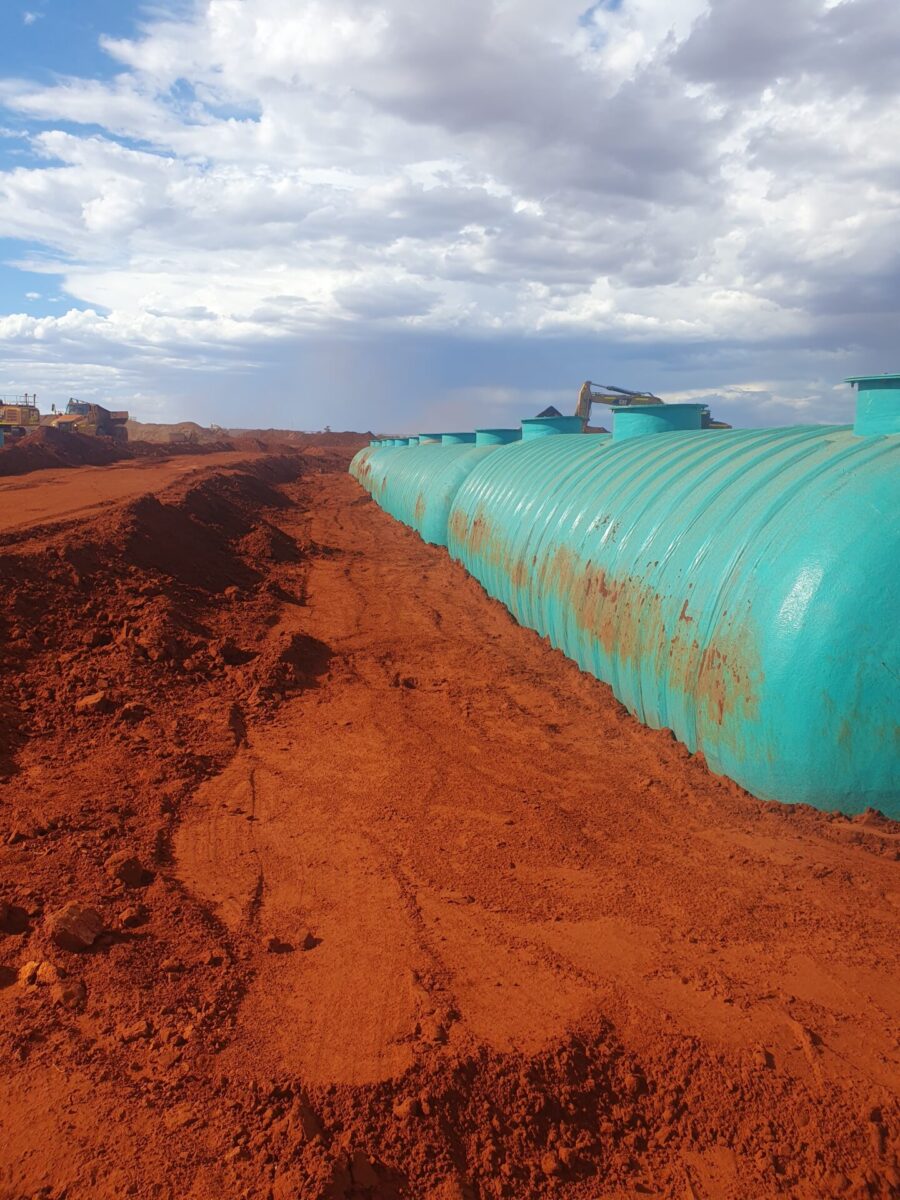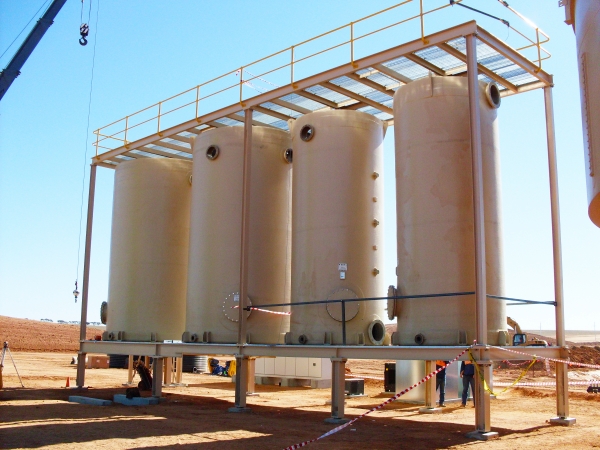Posted on 30/07/2025

When you’re investing in chemical or industrial storage tanks, the wrong choice can cost you, literally. Corrosion, cracking, installation downtime, and high replacement costs plague steel and concrete tanks across Australian industries. Whether you’re storing chemicals or potable water in the outback or on the coast, you need a solution built to withstand real-world conditions.
That’s why more project engineers, asset managers, and industrial operators are switching from traditional materials to fibreglass-reinforced plastic (FRP). In this guide, we break down the key differences between FRP vs steel tanks, explain why FRP is the better option in harsh Australian environments, and help you choose the right tank for your application.
Why FRP is Replacing Steel in Industrial Tank Design
Across Australia’s industrial, mining, and water treatment sectors, fibreglass-reinforced plastic (FRP) is fast becoming the preferred alternative to steel for chemical and liquid storage tanks. The reason? It performs where steel fails, especially in the harsh and remote environments that Australia is home to.
Unlike steel, which is prone to rust, galvanic corrosion, and structural fatigue over time, FRP is built from a resin matrix reinforced with glass fibres, offering exceptional chemical compatibility, UV resistance, and thermal stability. This makes it ideally suited to store aggressive chemical liquids without degradation, something steel tanks struggle with even when coated or lined.
At CSG Composites, we engineer each tank with a resin system tailored to your specific application. Whether you’re working with heated effluent, volatile chemicals, or potable water, our fiberglass chemical storage tanks provide long-term performance without the risk of corrosion, coating failure, or early replacement.
Explore our range of chemical process tanks designed to handle Australia’s most challenging environments.

Why Steel and Concrete Tanks Fail in Harsh Environments
If you operate in regional Australia, then you’re no stranger to extremes. Steel and concrete tanks may seem tough, but in practice, they:
- Corrode quickly in saline or acidic environments, especially without cathodic protection
- Crack or degrade under thermal stress or seismic movement
- Require heavy equipment and costly labour for transport and installation
- Add long-term maintenance costs, such as repainting, recoating, or relining
Even stainless steel, often seen as the gold standard, can degrade in aggressive chemical or coastal applications. And concrete, while chemically inert, lacks tensile flexibility and is prone to cracking.
By contrast, FRP tanks offer a proven track record of performance in mining, water treatment, agriculture, and petrochemical applications, all with lower maintenance and a longer service life.
FRP vs Steel: Comparison Table
| Feature | FRP Tanks | Steel Tanks |
| Corrosion Resistance | Excellent – non-metallic structure avoids rust or galvanic corrosion | Moderate – vulnerable to rust and requires protective coatings or liners |
| Weight & Installation | Lightweight – often easier to transport and install | Heavy – requires cranes and reinforced foundations |
| Chemical Compatibility | High – resin can be matched to most chemicals | Variable – sensitive to acids, alkalis, and certain fuels |
| Life Expectancy | Long – typically 30+ years with correct resin and usage | Medium – 10–20 years depending on conditions and coatings |
| Maintenance | Low – minimal upkeep required | Moderate to high – periodic recoating, inspections, rust management |
| Cost (Life Cycle) | Lower – less frequent repair or replacement over time | Higher – more ongoing maintenance and earlier replacements |
| Design Flexibility | High – moulded to many configurations and sizes | Moderate – more limited to prefabricated shapes and joins |
Applications Where FRP Outperforms Steel
Mining and Industrial Processing
In mining regions like WA’s Pilbara, FRP tanks handle everything from caustic process chemicals to abrasive slurries. Our tanks are engineered to withstand strong winds, UV exposure, and high temperatures, all while reducing transport and crane costs.
Read our article on Why FRP Tanks Are the Smart Choice for the Mining Industry.
Chemical and Petrochemical Storage
From sodium hypochlorite to fluorosilicic acid, FRP offers safe, long-term containment. At CSG Composites, our tanks are made to AS standards and engineered for the highest level of containment.
Water Treatment and Desalination
FRP tanks offer chemical compatibility with disinfectants, pH adjusters, and dosing chemicals, without the degradation risks of steel.
Agricultural and Rainwater Harvesting
Lightweight, bacteria-resistant, and custom-sized, FRP tanks are ideal for rural applications where water quality and long-term reliability matter.
Read our article on Rainwater Harvesting Tanks.
Proven Performance in Harsh Environments

CSG Composites has a proven track record of delivering high-performance FRP solutions in some of Australia’s toughest conditions. In a recent project with Arris, our team designed and manufactured a custom polypropylene-lined FRP tank to handle 40°C effluent in a high-humidity, chemical-laden environment.
Despite the demanding conditions, the tank was installed quickly and continues to perform reliably, demonstrating how FRP’s corrosion resistance, customisability, and structural integrity make it ideal for challenging industrial applications in harsh environments.
Read the full Arris case study to see how our composite expertise delivers results.
Frequently Asked Questions
Which Is Better, Fiberglass or Steel Well Tanks?
In water and wastewater applications, fiberglass well tanks shine. They’re non-toxic, bacteria-resistant, and do not require internal coatings that can peel or contaminate liquids. For potable water storage, FRP tanks provide hygienic, compliant, and durable industrial storage tank options without the risk of rust or leaching metals. They also offer superior thermal insulation, protecting water quality in hot, remote climates (a major issue for steel tanks) which can rapidly heat and encourage algae growth.
Do Fiberglass Tanks Need Protection from Corrosion?
No. Unlike steel or even concrete, fiberglass chemical storage tanks do not rust, pit, or corrode. The resin matrix itself is non-metallic and chemically resistant. When properly manufactured and maintained, FRP offers a corrosion-proof, watertight, and leak-free solution, with no need for liners or coatings.
How Long Will a Fiberglass Tank Last?
At CSG Composites, our FRP tanks are designed for a minimum 30-year service life and often exceed 50 years in the field. Some tanks, particularly those used for non-aggressive liquid storage in sheltered environments, can last even longer.
We back our products with long-term warranties and in-house engineering support, offering a proven track record in demanding Australian conditions.
Are There Any Limitations of FRP?
While fibreglass-reinforced plastic (FRP) is an excellent choice for many corrosive and remote-site applications, no material is perfect.
Temperature and chemical constraints: FRP tanks rely on the right resin system for performance. Some highly oxidising chemicals or extreme temperature environments may require specialised formulations. Improper resin selection can lead to degradation over time.
Initial cost: Compared to basic polyethylene or mild steel tanks, FRP can have a higher upfront cost. However, these are usually offset by lower maintenance and longer service life.
Manufacturing quality matters: FRP tanks must be properly designed and manufactured to avoid issues such as delamination or leaks. That’s why working with an experienced Australian supplier like CSG Composites is essential to ensure your tank performs to standard.
When engineered and installed correctly, FRP tanks remain one of the most reliable, safe, and cost-effective storage solutions for harsh environments.

Key Advantages of FRP Tanks from CSG Composites
- Australian owned and operated – built for local conditions
- Customised resin systems to match your chemical or thermal requirements
- Factory-manufactured and delivered ready to install
- Range of services including design, manufacturing and more
- Suitable for above-ground or underground installations
- Specialised composite solutions trusted by industry leaders
Why Choose FRP Over Steel?
Steel has long been the traditional choice for storage tanks, but tradition doesn’t hold up in the face of harsh Australian environments. If you’re looking for durable industrial storage tanks that offer long-term performance, safety, and reduced life-cycle costs, fibreglass-reinforced plastic is the smarter investment.
From mining and wastewater treatment to petrochemical storage and rural water harvesting, FRP tanks outperform steel in nearly every metric that matters.
Looking to Buy FRP Tanks in Australia?
At CSG Composites, we specialise in fiberglass chemical storage tanks built to last. Whether you’re planning a new project or upgrading ageing steel infrastructure, our team is here to help you find the right tank for your needs.
Contact our team today to discuss your project or request a quote.
Written by the CSG Composites Team
Industry Success
Client Testimonials
Scott Morris,
Radium
“It’s their knowledge of composites and FRP, the materials, the resins. It’s the experience they bring to the table with knowing the right compounds to put together is what makes the difference”
Jim Kelly,
Arris
“CSG Composites were very good to us as they were able to meet the short lead time and have the tanks ready to go”
